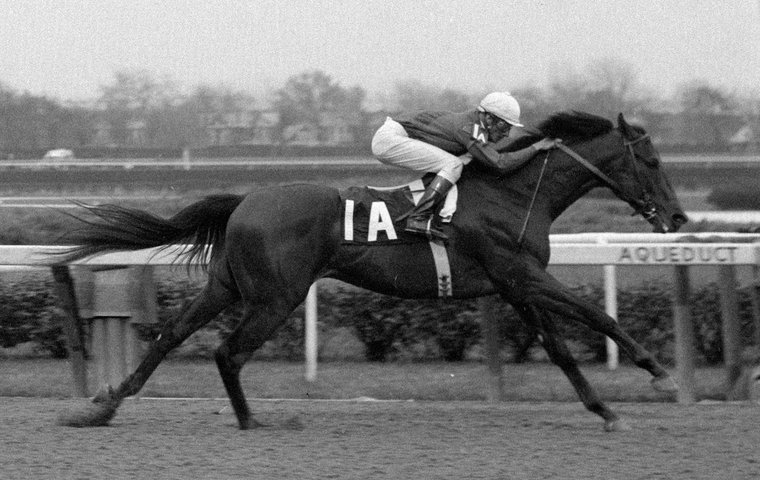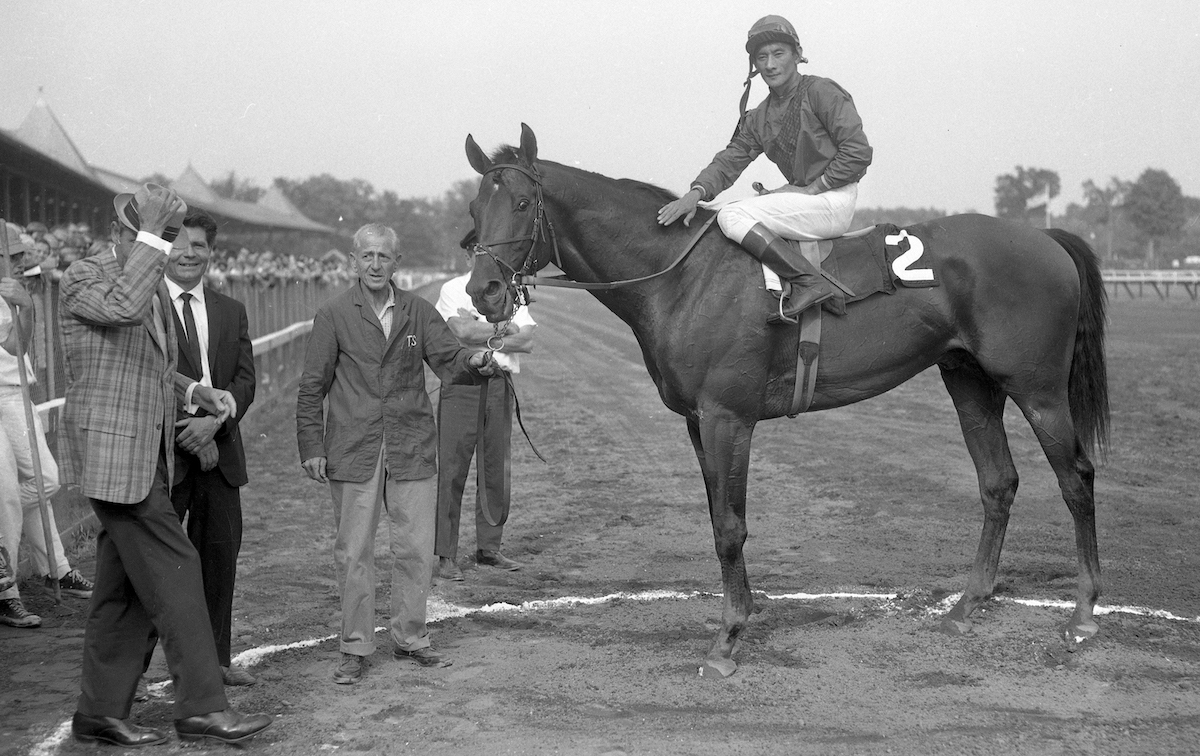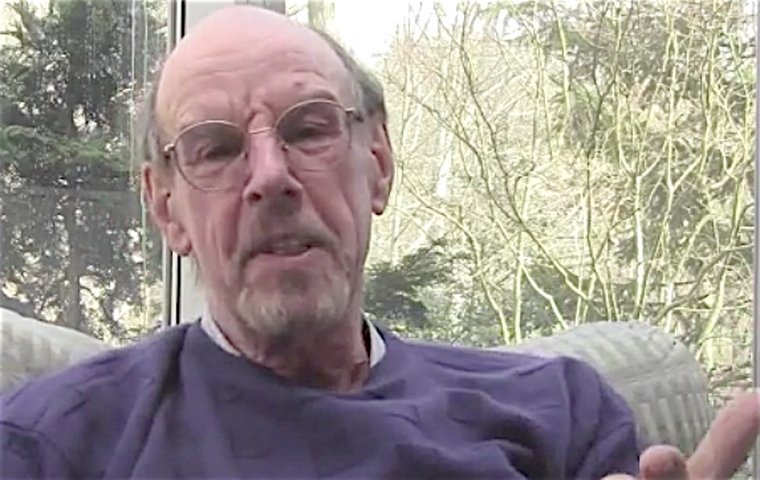
The late Richard Aller gained notoriety as a cheerleader for the great Dr. Fager, whom he claimed with missionary zeal achieved more during his Horse of the Year campaign than even the legendary Secretariat. Steve Dennis tells the story of one fan’s enduring devotion to a horse.
USA: Everyone has a favourite horse. At some point in our racing experience, usually early on, one of these remarkable animals gets under our skin and fits perfectly into the horse-shaped hole in our hearts that we never knew existed until then. Richard Aller had a favourite horse.
This is a tale of obsession, of a benevolent, non-dangerous obsession held by one man for his horse that speaks to all of us. You, reader, would understand Aller. You may not agree with him, but you would recognise something of yourself in his unadorned adoration for his horse. Aller was a fan, a superfan, a hopelessly devoted nerd worshipping at his chosen altar; Aller – who died in 2019 at the age of 75 – was one of us.
Aller’s horse was Dr. Fager, one of the all-time greats of US racing, such an exciting horse, a Hall of Famer who won 18 of his 22 races over a three-year career and in 1968, as a four-year-old, produced arguably the greatest season of any horse who ever raced, winning seven of his eight starts and later on garnering an astounding four Eclipse Awards – Horse of the Year, champion sprinter, champion handicap horse and joint-champion turf horse.
Note the word ‘arguably’; that’s where Aller comes in. “Not one person in the US can refute what I say,” Aller once told the Los Angeles Times. “I’ll argue that with anybody.”
High point of equine endeavour
The unshakeable core of Aller’s argument, the uncrackable kernel of this Dr. Fager nut, was that there was no argument, that Dr. Fager’s otherworldly 1968 campaign was absolutely the high point of equine endeavour, superior to Secretariat’s 1973 season, to Spectacular Bid’s unbeaten 1980 tour de force, to any year in history.
Aller always maintained that he wasn’t saying that Dr. Fager was the greatest horse ever, just that he recorded the greatest season ever. It is an unconventional viewpoint, but then Aller was an unconventional guy.
He was not a racing insider, a wise-we-boys member of the backstretch literati, but he loved the sport. Away from the white rail he was a history teacher and gym coach at Compton High School in Los Angeles, and a familiar sight at baseball’s Dodger Stadium where he was a long-term peanut vendor, to supplement his teacher’s salary. As an aside – Aller’s life was fruitful with asides – he was once fired for the heinous crime of ‘misappropriation of peanuts’ but later reinstated.
The story in the LA Times referenced Aller’s “wisecracking, sarcastic style, beloved by fans” and included a quote from a Dodgers fan who stated that “people get season tickets just to be in his section”. In Aller’s rough-hewn magnetism, in his maverick persistence, Dr. Fager had the perfect cheerleader.
So what was it about Dr. Fager’s seven-for-eight year for all the ages that, according to Aller, entitled it to a place on the highest pedestal? Two factors: weight and speed.
 Dr. Fager – trained by John Nerud, and owned by William McKnight’s Tartan Stable – was a freak of nature, and he did things that horses today could never match, most of all carrying weight like a prospector’s mule.
Dr. Fager – trained by John Nerud, and owned by William McKnight’s Tartan Stable – was a freak of nature, and he did things that horses today could never match, most of all carrying weight like a prospector’s mule.
Here are the imposts for his eight races in 1968: 130lb, 130, 132, 135, 132, 134, 134, 139. Racing between seven furlongs and a mile and a quarter, on dirt and turf, with his schedule including storied old races such as the Suburban Handicap, the Whitney Stakes and the Vosburgh Handicap, Dr. Fager set three track records including a world record for a mile that remains a US standard on dirt. His only defeat that year came courtesy of 1967 Horse of the Year Damascus, who beat him by two and a half lengths in the ten-furlong Brooklyn Handicap when receiving 5lb.
‘A horse never lived that could beat him up to a mile’
“A horse never lived that could beat him up to a mile. He never did anything but run as fast as he could,” said Nerud, and Dr. Fager – named after the neurosurgeon who once saved Nerud’s life – was a fearsome, ferocious sight on racetracks, with his long, loose mane and forelock flapping like a gypsy pony while he reliably ran a hole in the wind.
On his final start Dr. Fager won the Vosburgh at Aqueduct in a track record under a head-spinning 139lb, but even that wasn’t the high-water mark in a career full of finest hours. That came on August 24, 1968, in the Washington Park Handicap over a mile at Arlington Park, when he carried 134lb including Braulio Baeza to an eased-down ten-length win in a world-record time of 1:32 and one-fifth.
Relive it on YouTube. The rococo racecall of Phil Georgeff dwindled to silence after Dr. Fager barrelled across the line, out on his own in more ways than one, until the microphone picked up in the background the single word ‘wow’, Georgeff speaking for everyone, using a word that defined this outstanding colt.
Dr. Fager’s world record would stand for 29 years. No horse has ever run faster over a mile on dirt in the US.
This performance, allied to the other six victories (plus that gallant defeat), was the gasoline that fired Aller’s lifelong conviction that nothing before or after could surpass Dr. Fager’s transcendent year. And that included humans.
“If you consider a horse an athlete – some do, some don’t, I won’t argue [a refreshing departure from the usual Aller doctrine] – it was the greatest single season in 20th-century sport,” said Aller. He was still propounding this assertion 50 years later, when with that gravelly voice full of unbrookable certitude he narrated a YouTube video that encapsulated his life’s mission.
“The fastest horse of all time, able to accelerate quarter-mile splits faster than any horse who ever raced. He got faster as he carried more weight, defying the laws of physics.
“He could sprint, he could come home, he could come around horses, he did it all – but he didn’t do it in the Triple Crown, so he’ll never get his just dues.”
Aller contended that circumstance was largely to blame for the critical neglect of Dr. Fager’s supernova brilliance. 1968 was an exceptionally turbulent year, news stories including the assassinations of Martin Luther King and Robert Kennedy, the Vietnam War, the Soviet invasion of Czechoslovakia, the Black Power salutes of Tommie Smith and John Carlos on the medal rostrum at the Mexico Olympics, race riots, student unrest, the Sixties expiring in a welter of anger and anguish.
‘I realised a terrible mistake had been made’
“The most tumultuous year of the 20th century,” added Aller. “And Dr. Fager was not on national television. Secretariat’s Triple Crown of 1973 was on national television, and Secretariat became visibly a shrine.
“I have a great deal of respect for Secretariat, but in the course of my studies I realised that a terrible, historical mistake had been made.
“Anywhere, any place, any time, any conditions, any weight, any competition, Dr. Fager’s there every time. All you have to do is sit people down and show them the facts. It’s absolutely irrefutable.”
Is it, though? Or is Aller just a man with the wrong end of the stick, shaking it at the racing Establishment with impotent, inaccurate fury?
Secretariat won the Triple Crown in 1973 with a venerated triptych of unnatural feats, culminating in what even Aller wouldn’t argue against being the single greatest performance by any Thoroughbred, when he won the Belmont Stakes by 31 lengths in a world record 2m 24s. Yet that year Secretariat was beaten by relative nonentities in Prove Out, Onion and Angle Light.
Seven years later Spectacular Bid went nine-for-nine (one a walkover) including his own track-record victory in the Washington Park Handicap, which by then was run at a mile-eighth.
Were these better campaigns than that of Dr. Fager? Andrew Beyer, the celebrated architect of speed ratings and a man better placed than most to assess the merits of a running horse, thinks so.
 “I began to devise the Beyer Speed Figures in 1970, and they were in a developmental stage throughout that decade, so I can’t use them to evaluate horses prior to 1980 with any confidence,” he says.
“I began to devise the Beyer Speed Figures in 1970, and they were in a developmental stage throughout that decade, so I can’t use them to evaluate horses prior to 1980 with any confidence,” he says.
‘Getting involved in hot speed duels is part of life’
“I imagine that Dr. Fager earned some spectacular speed figures, but I think that the overall achievements of both Secretariat and Spectacular Bid were greater.
“Dr. Fager had four meetings with his arch-rival Damascus, and lost two of them when he was compromised by duelling with Damascus’s stablemate Hedevar. But getting involved in hot speed duels is part of life for speedballs like Dr. Fager, and his two losses to Damascus taint his record.”
Yet renowned former Blood-Horse writer Steve Haskin sits at Aller’s end of the table. On his widely-read blog ‘Hangin’ With Haskin’, he wrote: “… it was certainly the greatest year by a Thoroughbred that I have ever seen …”
Here is the old, perennial problem. Comparisons between greats of different eras is fraught with difficulty, and attempts at objectivity are only that – attempts. For sure, Dr. Fager never produced one single performance to match Secretariat’s greatest single performance, but Dr. Fager was only ever beaten by champions, and Secretariat lost to lesser horses. And great years are best remembered with comradely affection rather than being traded against each other en route to an unreachable conclusion.
In his heart, Aller knew this. He just wanted to continue the debate, to provoke recognition, to stand up for his favourite horse, the horse who got under his skin when he saw him win the Californian Stakes at Hollywood Park in May 1968. School was out; no-one needed peanuts that day; Aller went to the track instead and found his obsession.
Dr. Fager died from colic in 1976. Nerud died in 2015 at the age of 102. Aller died in 2019, still preaching the glory of the season of ’68. On his memorial page online, his former students remember him as a wonderful teacher, a favourite teacher, a great person, a legend. One writes of him that “your legacy will live on”.
She could have been writing about Dr. Fager. Aller would have liked that. That’s what it had all been about, the horse of a lifetime, his lifetime.
Where the clock is king: which are the oldest track records still standing in the US?
Eureka moment: Secretariat’s son Maritime Traveler is a welcome surprise
The making of the Triple Crown: how Sir Barton broke his maiden in the Kentucky Derby
View the latest TRC Global Rankings for horses / jockeys / trainers / sires


